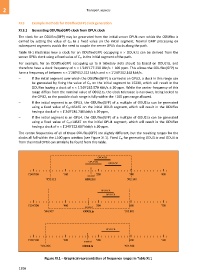Page 1310 - 5G Basics - Core Network Aspects
P. 1310
2 Transport aspects
XI.3 Example methods for ODUflex(GFP) clock generation
XI.3.1 Generating ODUflex(GFP) clock from OPUk clock
The clock for an ODUflex(GFP) may be generated from the initial server OPUk over which the ODUflex is
carried by setting the value of Cm to a fixed value on the initial segment. Normal GMP processing on
subsequent segments avoids the need to couple the server OPUk clocks along the path.
Table XI-1 illustrates how a clock for an ODUflex(GFP) occupying n ODUk.ts can be derived from the
server OPUk clock using a fixed value of Cm in the initial segment of the path.
For example, for an ODUflex(GFP) occupying up to 8 tributary slots should be based on ODU2.ts, and
therefore have a clock frequency of n 1'249'177.230 kbit/s 100 ppm. This allows the ODUflex(GFP) to
have a frequency of between n 1'249'052.312 kbit/s and n 1'249'302.148 kbit/s.
– If the initial segment over which the ODUflex(GFP) is carried is an OPU2, a clock in this range can
be generated by fixing the value of Cm on the initial segment to 15230, which will result in the
ODUflex having a clock of n 1'249'245.570 kbit/s 20 ppm. While the center frequency of this
range differs from the nominal value of ODU2.ts, the clock tolerance is narrower, being locked to
the OPU2, so the possible clock range is fully within the 100 ppm range allowed.
– If the initial segment is an OPU3, the ODUflex(GFP) of a multiple of ODU2.ts can be generated
using a fixed value of Cm=15165 on the initial ODU3 segment, which will result in the ODUflex
having a clock of n 1'249'184.746 kbit/s 20 ppm,
– If the initial segment is an OPU4, the ODUflex(GFP) of a multiple of ODU2.ts can be generated
using a fixed value of Cm=14587 on the initial OPU4 segment, which will result in the ODUflex
having a clock of n 1'249'212.687 kbit/s 20 ppm.
The center frequencies of all of these ODUflex(GFP) are slightly different, but the resulting ranges for the
clocks all fall within the 100 ppm window (see Figure XI.1). Fixed Cm for generating ODU3.ts and ODU4.ts
from the initial OPUk can similarly be found from this table.
OPU4 CK
OPU3 CK
OPU2 CK
1'249'000 '100 nominal '200 ' 300 '400
'052.312 ODU2.ts '302.148
OPU4 CK
OPU3 CK
1'254'300 '400 nominal '500 ' 600 '700
'344.907 ODU3.ts '595.801
OPU4 CK
1'301'300 '400 nominal '500 ' 600 '700
'336.986 ODU4.ts '597.280
Figure XI.1 – Graphical representation of frequency ranges in Table XI.1
1300

